PUBH6007: Mental Health Needs Assessment in Indigenous Communities
VerifiedAdded on 2022/11/18
|10
|2039
|370
Report
AI Summary
This report provides a needs assessment of mental health within Indigenous communities, focusing on the challenges and potential improvements. It begins by examining the importance of mental wellbeing and the factors contributing to mental health issues, such as limited access to healthcare and social exclusion. The report then explores potential changes, emphasizing the need for communication and understanding of cultural factors. A SWOT analysis is conducted to identify strengths, weaknesses, opportunities, and threats. Based on the assessment, the report proposes community development programs, such as trauma-informed approaches, to address historical and ongoing challenges. The conclusion emphasizes the importance of holistic approaches and systematic interventions to improve mental health outcomes within Indigenous communities. The report references various studies and guidelines to support its findings and recommendations.
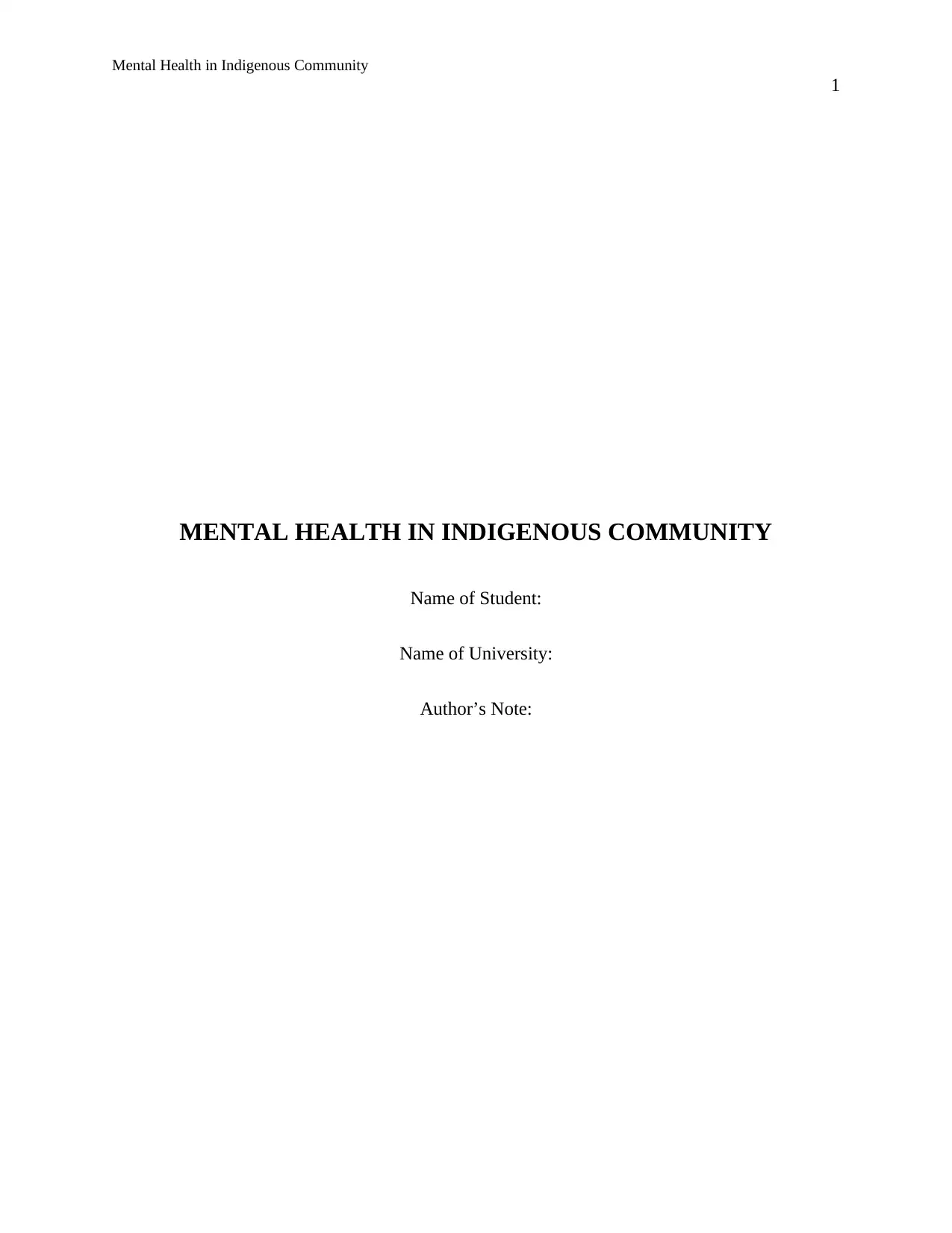
Mental Health in Indigenous Community
1
MENTAL HEALTH IN INDIGENOUS COMMUNITY
Name of Student:
Name of University:
Author’s Note:
1
MENTAL HEALTH IN INDIGENOUS COMMUNITY
Name of Student:
Name of University:
Author’s Note:
Paraphrase This Document
Need a fresh take? Get an instant paraphrase of this document with our AI Paraphraser
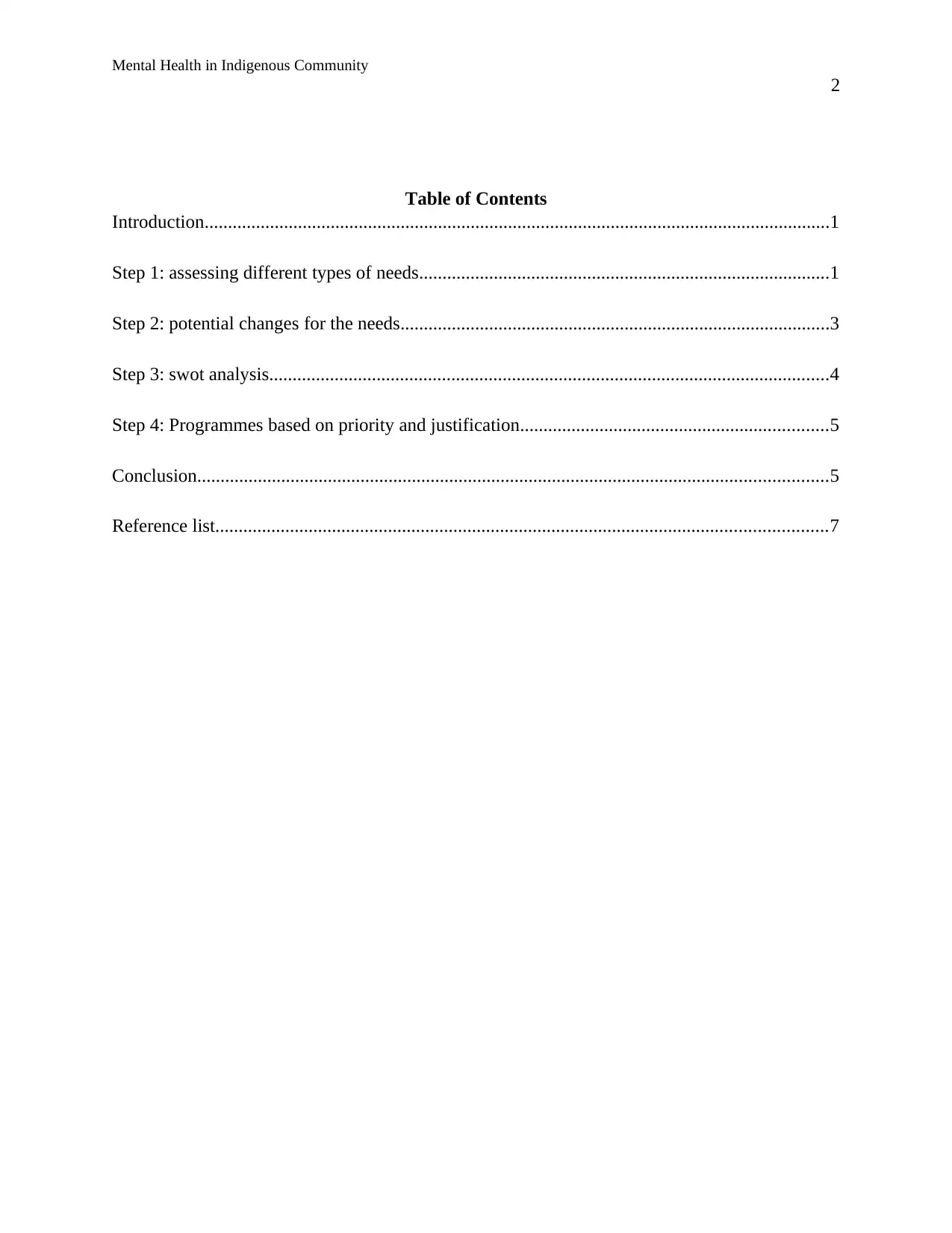
Mental Health in Indigenous Community
2
Table of Contents
Introduction......................................................................................................................................1
Step 1: assessing different types of needs........................................................................................1
Step 2: potential changes for the needs............................................................................................3
Step 3: swot analysis........................................................................................................................4
Step 4: Programmes based on priority and justification..................................................................5
Conclusion.......................................................................................................................................5
Reference list...................................................................................................................................7
2
Table of Contents
Introduction......................................................................................................................................1
Step 1: assessing different types of needs........................................................................................1
Step 2: potential changes for the needs............................................................................................3
Step 3: swot analysis........................................................................................................................4
Step 4: Programmes based on priority and justification..................................................................5
Conclusion.......................................................................................................................................5
Reference list...................................................................................................................................7
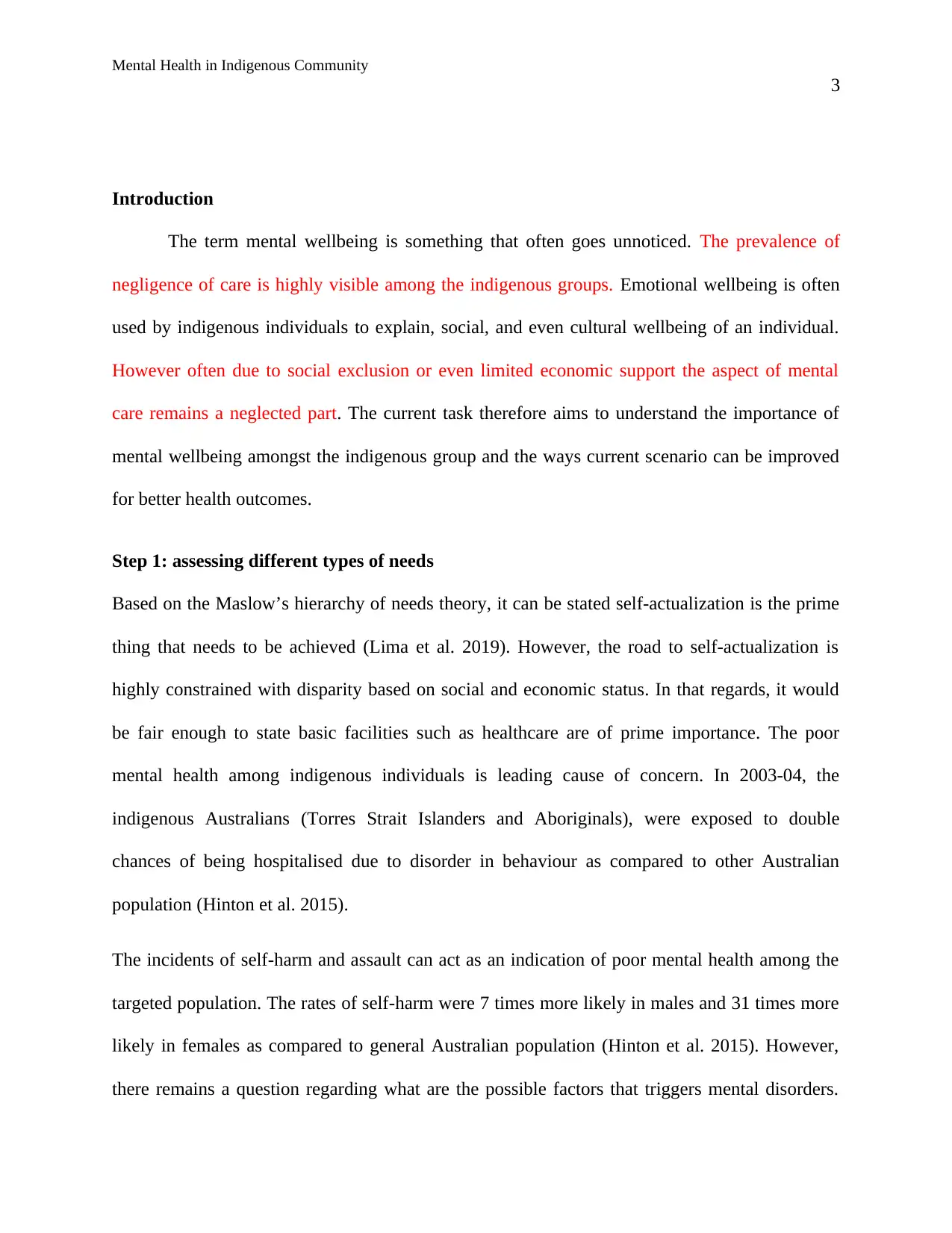
Mental Health in Indigenous Community
3
Introduction
The term mental wellbeing is something that often goes unnoticed. The prevalence of
negligence of care is highly visible among the indigenous groups. Emotional wellbeing is often
used by indigenous individuals to explain, social, and even cultural wellbeing of an individual.
However often due to social exclusion or even limited economic support the aspect of mental
care remains a neglected part. The current task therefore aims to understand the importance of
mental wellbeing amongst the indigenous group and the ways current scenario can be improved
for better health outcomes.
Step 1: assessing different types of needs
Based on the Maslow’s hierarchy of needs theory, it can be stated self-actualization is the prime
thing that needs to be achieved (Lima et al. 2019). However, the road to self-actualization is
highly constrained with disparity based on social and economic status. In that regards, it would
be fair enough to state basic facilities such as healthcare are of prime importance. The poor
mental health among indigenous individuals is leading cause of concern. In 2003-04, the
indigenous Australians (Torres Strait Islanders and Aboriginals), were exposed to double
chances of being hospitalised due to disorder in behaviour as compared to other Australian
population (Hinton et al. 2015).
The incidents of self-harm and assault can act as an indication of poor mental health among the
targeted population. The rates of self-harm were 7 times more likely in males and 31 times more
likely in females as compared to general Australian population (Hinton et al. 2015). However,
there remains a question regarding what are the possible factors that triggers mental disorders.
3
Introduction
The term mental wellbeing is something that often goes unnoticed. The prevalence of
negligence of care is highly visible among the indigenous groups. Emotional wellbeing is often
used by indigenous individuals to explain, social, and even cultural wellbeing of an individual.
However often due to social exclusion or even limited economic support the aspect of mental
care remains a neglected part. The current task therefore aims to understand the importance of
mental wellbeing amongst the indigenous group and the ways current scenario can be improved
for better health outcomes.
Step 1: assessing different types of needs
Based on the Maslow’s hierarchy of needs theory, it can be stated self-actualization is the prime
thing that needs to be achieved (Lima et al. 2019). However, the road to self-actualization is
highly constrained with disparity based on social and economic status. In that regards, it would
be fair enough to state basic facilities such as healthcare are of prime importance. The poor
mental health among indigenous individuals is leading cause of concern. In 2003-04, the
indigenous Australians (Torres Strait Islanders and Aboriginals), were exposed to double
chances of being hospitalised due to disorder in behaviour as compared to other Australian
population (Hinton et al. 2015).
The incidents of self-harm and assault can act as an indication of poor mental health among the
targeted population. The rates of self-harm were 7 times more likely in males and 31 times more
likely in females as compared to general Australian population (Hinton et al. 2015). However,
there remains a question regarding what are the possible factors that triggers mental disorders.
⊘ This is a preview!⊘
Do you want full access?
Subscribe today to unlock all pages.

Trusted by 1+ million students worldwide
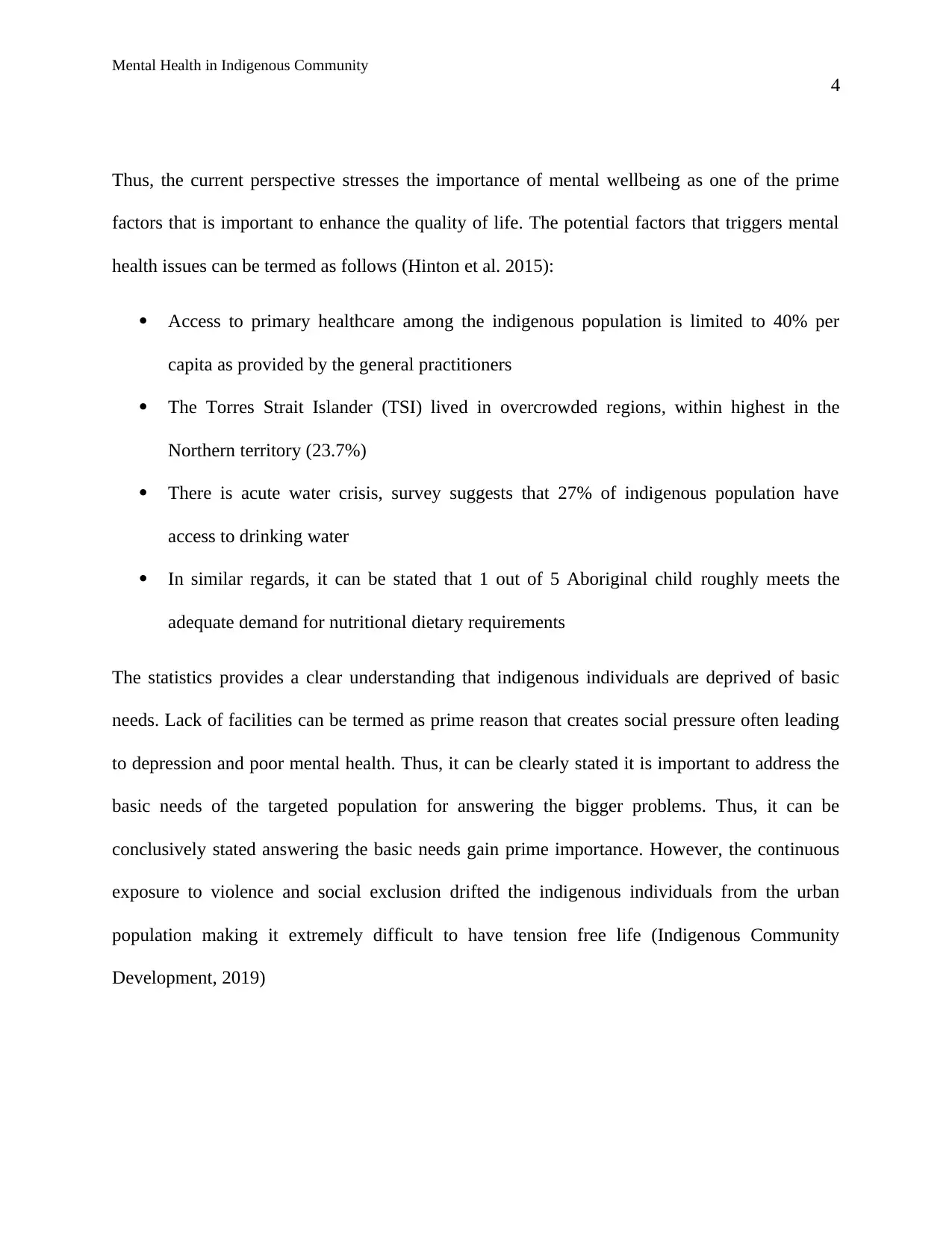
Mental Health in Indigenous Community
4
Thus, the current perspective stresses the importance of mental wellbeing as one of the prime
factors that is important to enhance the quality of life. The potential factors that triggers mental
health issues can be termed as follows (Hinton et al. 2015):
Access to primary healthcare among the indigenous population is limited to 40% per
capita as provided by the general practitioners
The Torres Strait Islander (TSI) lived in overcrowded regions, within highest in the
Northern territory (23.7%)
There is acute water crisis, survey suggests that 27% of indigenous population have
access to drinking water
In similar regards, it can be stated that 1 out of 5 Aboriginal child roughly meets the
adequate demand for nutritional dietary requirements
The statistics provides a clear understanding that indigenous individuals are deprived of basic
needs. Lack of facilities can be termed as prime reason that creates social pressure often leading
to depression and poor mental health. Thus, it can be clearly stated it is important to address the
basic needs of the targeted population for answering the bigger problems. Thus, it can be
conclusively stated answering the basic needs gain prime importance. However, the continuous
exposure to violence and social exclusion drifted the indigenous individuals from the urban
population making it extremely difficult to have tension free life (Indigenous Community
Development, 2019)
4
Thus, the current perspective stresses the importance of mental wellbeing as one of the prime
factors that is important to enhance the quality of life. The potential factors that triggers mental
health issues can be termed as follows (Hinton et al. 2015):
Access to primary healthcare among the indigenous population is limited to 40% per
capita as provided by the general practitioners
The Torres Strait Islander (TSI) lived in overcrowded regions, within highest in the
Northern territory (23.7%)
There is acute water crisis, survey suggests that 27% of indigenous population have
access to drinking water
In similar regards, it can be stated that 1 out of 5 Aboriginal child roughly meets the
adequate demand for nutritional dietary requirements
The statistics provides a clear understanding that indigenous individuals are deprived of basic
needs. Lack of facilities can be termed as prime reason that creates social pressure often leading
to depression and poor mental health. Thus, it can be clearly stated it is important to address the
basic needs of the targeted population for answering the bigger problems. Thus, it can be
conclusively stated answering the basic needs gain prime importance. However, the continuous
exposure to violence and social exclusion drifted the indigenous individuals from the urban
population making it extremely difficult to have tension free life (Indigenous Community
Development, 2019)
Paraphrase This Document
Need a fresh take? Get an instant paraphrase of this document with our AI Paraphraser
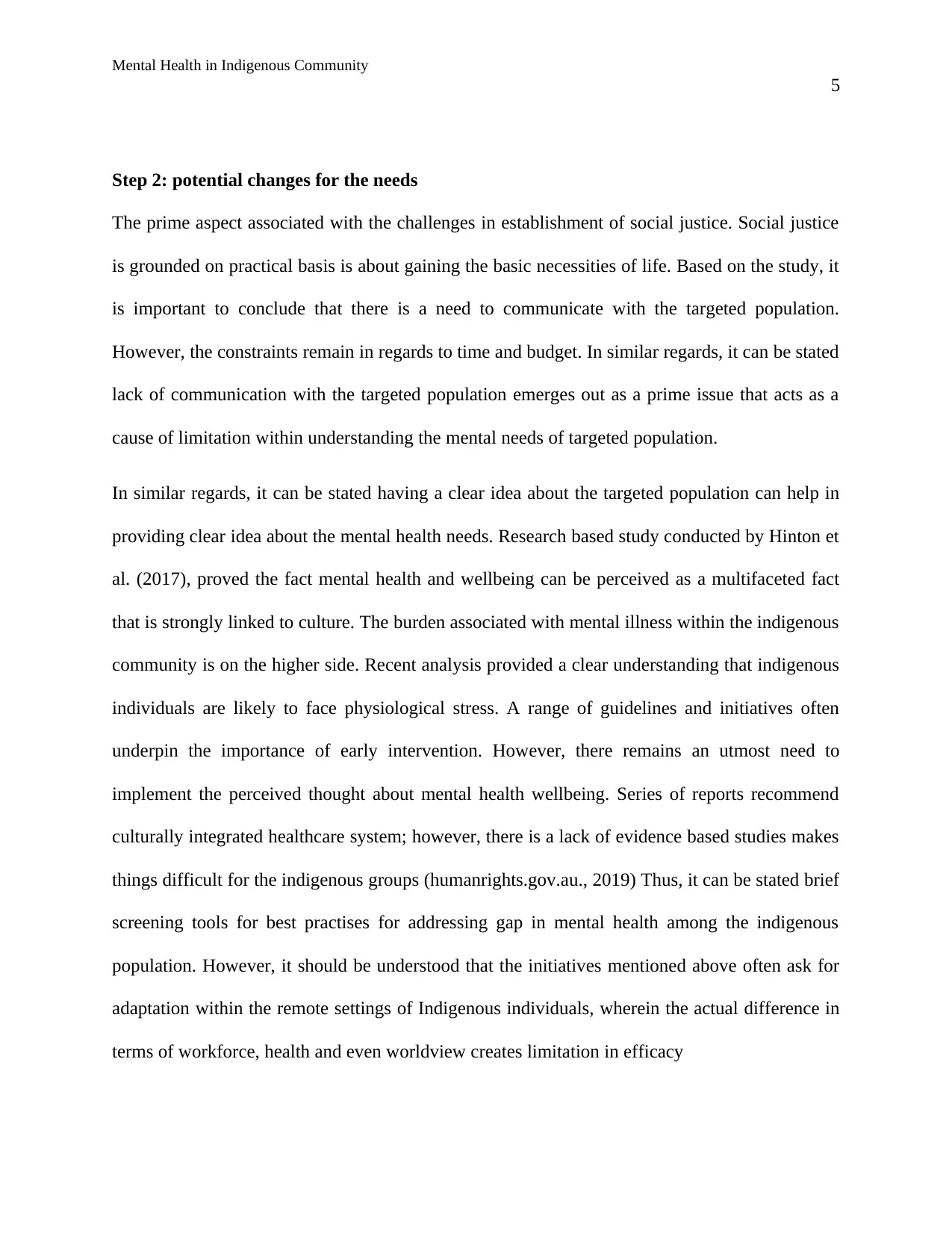
Mental Health in Indigenous Community
5
Step 2: potential changes for the needs
The prime aspect associated with the challenges in establishment of social justice. Social justice
is grounded on practical basis is about gaining the basic necessities of life. Based on the study, it
is important to conclude that there is a need to communicate with the targeted population.
However, the constraints remain in regards to time and budget. In similar regards, it can be stated
lack of communication with the targeted population emerges out as a prime issue that acts as a
cause of limitation within understanding the mental needs of targeted population.
In similar regards, it can be stated having a clear idea about the targeted population can help in
providing clear idea about the mental health needs. Research based study conducted by Hinton et
al. (2017), proved the fact mental health and wellbeing can be perceived as a multifaceted fact
that is strongly linked to culture. The burden associated with mental illness within the indigenous
community is on the higher side. Recent analysis provided a clear understanding that indigenous
individuals are likely to face physiological stress. A range of guidelines and initiatives often
underpin the importance of early intervention. However, there remains an utmost need to
implement the perceived thought about mental health wellbeing. Series of reports recommend
culturally integrated healthcare system; however, there is a lack of evidence based studies makes
things difficult for the indigenous groups (humanrights.gov.au., 2019) Thus, it can be stated brief
screening tools for best practises for addressing gap in mental health among the indigenous
population. However, it should be understood that the initiatives mentioned above often ask for
adaptation within the remote settings of Indigenous individuals, wherein the actual difference in
terms of workforce, health and even worldview creates limitation in efficacy
5
Step 2: potential changes for the needs
The prime aspect associated with the challenges in establishment of social justice. Social justice
is grounded on practical basis is about gaining the basic necessities of life. Based on the study, it
is important to conclude that there is a need to communicate with the targeted population.
However, the constraints remain in regards to time and budget. In similar regards, it can be stated
lack of communication with the targeted population emerges out as a prime issue that acts as a
cause of limitation within understanding the mental needs of targeted population.
In similar regards, it can be stated having a clear idea about the targeted population can help in
providing clear idea about the mental health needs. Research based study conducted by Hinton et
al. (2017), proved the fact mental health and wellbeing can be perceived as a multifaceted fact
that is strongly linked to culture. The burden associated with mental illness within the indigenous
community is on the higher side. Recent analysis provided a clear understanding that indigenous
individuals are likely to face physiological stress. A range of guidelines and initiatives often
underpin the importance of early intervention. However, there remains an utmost need to
implement the perceived thought about mental health wellbeing. Series of reports recommend
culturally integrated healthcare system; however, there is a lack of evidence based studies makes
things difficult for the indigenous groups (humanrights.gov.au., 2019) Thus, it can be stated brief
screening tools for best practises for addressing gap in mental health among the indigenous
population. However, it should be understood that the initiatives mentioned above often ask for
adaptation within the remote settings of Indigenous individuals, wherein the actual difference in
terms of workforce, health and even worldview creates limitation in efficacy
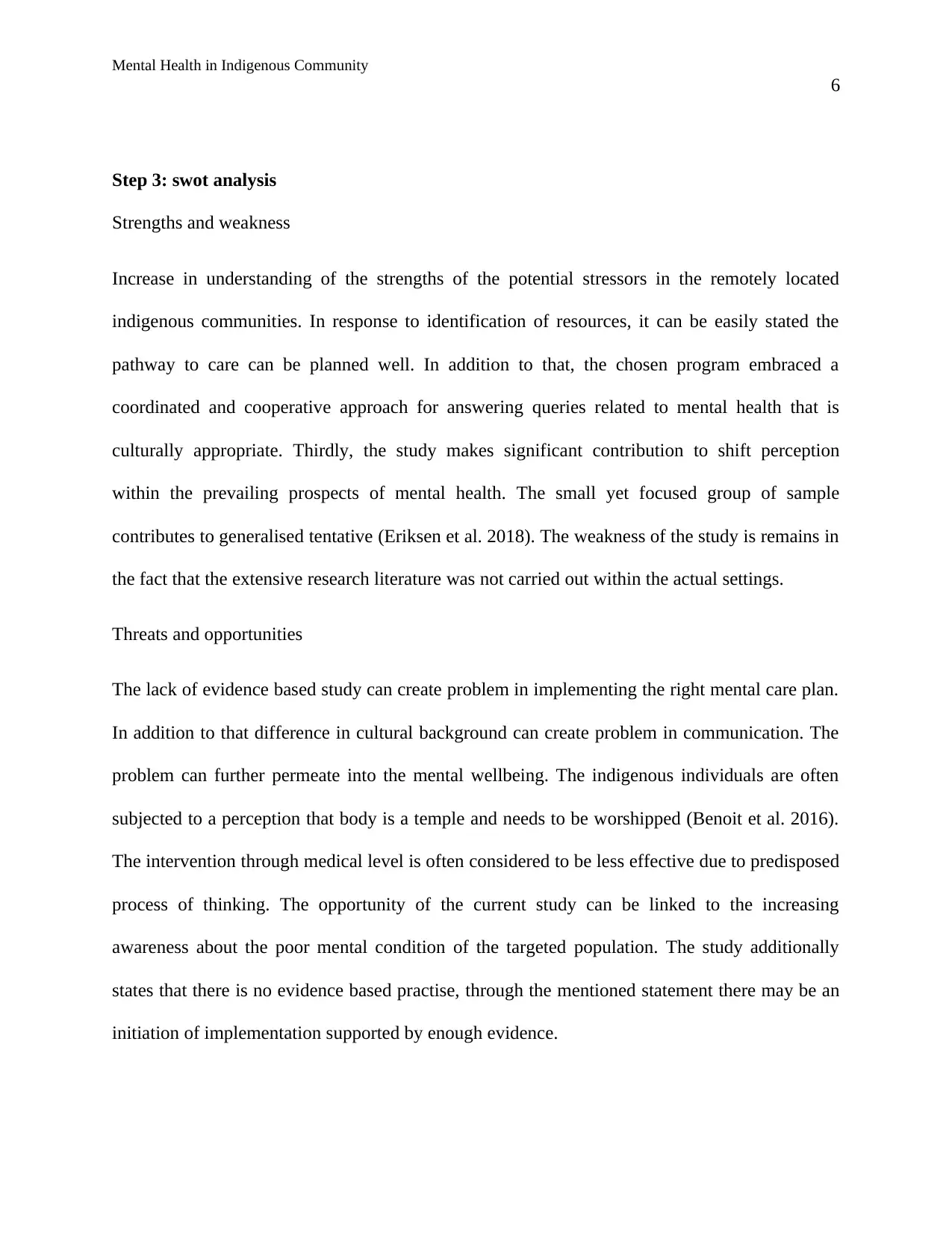
Mental Health in Indigenous Community
6
Step 3: swot analysis
Strengths and weakness
Increase in understanding of the strengths of the potential stressors in the remotely located
indigenous communities. In response to identification of resources, it can be easily stated the
pathway to care can be planned well. In addition to that, the chosen program embraced a
coordinated and cooperative approach for answering queries related to mental health that is
culturally appropriate. Thirdly, the study makes significant contribution to shift perception
within the prevailing prospects of mental health. The small yet focused group of sample
contributes to generalised tentative (Eriksen et al. 2018). The weakness of the study is remains in
the fact that the extensive research literature was not carried out within the actual settings.
Threats and opportunities
The lack of evidence based study can create problem in implementing the right mental care plan.
In addition to that difference in cultural background can create problem in communication. The
problem can further permeate into the mental wellbeing. The indigenous individuals are often
subjected to a perception that body is a temple and needs to be worshipped (Benoit et al. 2016).
The intervention through medical level is often considered to be less effective due to predisposed
process of thinking. The opportunity of the current study can be linked to the increasing
awareness about the poor mental condition of the targeted population. The study additionally
states that there is no evidence based practise, through the mentioned statement there may be an
initiation of implementation supported by enough evidence.
6
Step 3: swot analysis
Strengths and weakness
Increase in understanding of the strengths of the potential stressors in the remotely located
indigenous communities. In response to identification of resources, it can be easily stated the
pathway to care can be planned well. In addition to that, the chosen program embraced a
coordinated and cooperative approach for answering queries related to mental health that is
culturally appropriate. Thirdly, the study makes significant contribution to shift perception
within the prevailing prospects of mental health. The small yet focused group of sample
contributes to generalised tentative (Eriksen et al. 2018). The weakness of the study is remains in
the fact that the extensive research literature was not carried out within the actual settings.
Threats and opportunities
The lack of evidence based study can create problem in implementing the right mental care plan.
In addition to that difference in cultural background can create problem in communication. The
problem can further permeate into the mental wellbeing. The indigenous individuals are often
subjected to a perception that body is a temple and needs to be worshipped (Benoit et al. 2016).
The intervention through medical level is often considered to be less effective due to predisposed
process of thinking. The opportunity of the current study can be linked to the increasing
awareness about the poor mental condition of the targeted population. The study additionally
states that there is no evidence based practise, through the mentioned statement there may be an
initiation of implementation supported by enough evidence.
⊘ This is a preview!⊘
Do you want full access?
Subscribe today to unlock all pages.

Trusted by 1+ million students worldwide
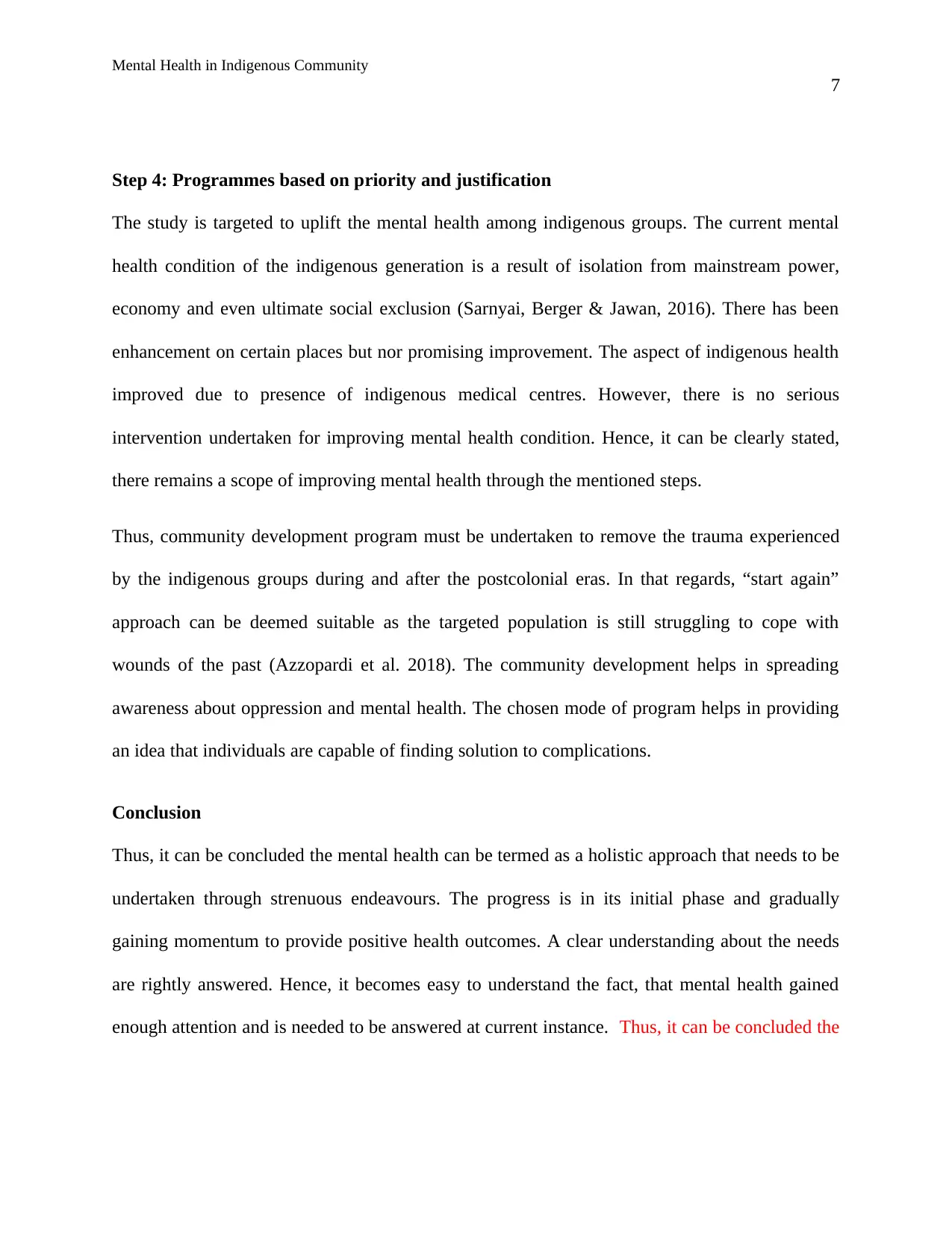
Mental Health in Indigenous Community
7
Step 4: Programmes based on priority and justification
The study is targeted to uplift the mental health among indigenous groups. The current mental
health condition of the indigenous generation is a result of isolation from mainstream power,
economy and even ultimate social exclusion (Sarnyai, Berger & Jawan, 2016). There has been
enhancement on certain places but nor promising improvement. The aspect of indigenous health
improved due to presence of indigenous medical centres. However, there is no serious
intervention undertaken for improving mental health condition. Hence, it can be clearly stated,
there remains a scope of improving mental health through the mentioned steps.
Thus, community development program must be undertaken to remove the trauma experienced
by the indigenous groups during and after the postcolonial eras. In that regards, “start again”
approach can be deemed suitable as the targeted population is still struggling to cope with
wounds of the past (Azzopardi et al. 2018). The community development helps in spreading
awareness about oppression and mental health. The chosen mode of program helps in providing
an idea that individuals are capable of finding solution to complications.
Conclusion
Thus, it can be concluded the mental health can be termed as a holistic approach that needs to be
undertaken through strenuous endeavours. The progress is in its initial phase and gradually
gaining momentum to provide positive health outcomes. A clear understanding about the needs
are rightly answered. Hence, it becomes easy to understand the fact, that mental health gained
enough attention and is needed to be answered at current instance. Thus, it can be concluded the
7
Step 4: Programmes based on priority and justification
The study is targeted to uplift the mental health among indigenous groups. The current mental
health condition of the indigenous generation is a result of isolation from mainstream power,
economy and even ultimate social exclusion (Sarnyai, Berger & Jawan, 2016). There has been
enhancement on certain places but nor promising improvement. The aspect of indigenous health
improved due to presence of indigenous medical centres. However, there is no serious
intervention undertaken for improving mental health condition. Hence, it can be clearly stated,
there remains a scope of improving mental health through the mentioned steps.
Thus, community development program must be undertaken to remove the trauma experienced
by the indigenous groups during and after the postcolonial eras. In that regards, “start again”
approach can be deemed suitable as the targeted population is still struggling to cope with
wounds of the past (Azzopardi et al. 2018). The community development helps in spreading
awareness about oppression and mental health. The chosen mode of program helps in providing
an idea that individuals are capable of finding solution to complications.
Conclusion
Thus, it can be concluded the mental health can be termed as a holistic approach that needs to be
undertaken through strenuous endeavours. The progress is in its initial phase and gradually
gaining momentum to provide positive health outcomes. A clear understanding about the needs
are rightly answered. Hence, it becomes easy to understand the fact, that mental health gained
enough attention and is needed to be answered at current instance. Thus, it can be concluded the
Paraphrase This Document
Need a fresh take? Get an instant paraphrase of this document with our AI Paraphraser

Mental Health in Indigenous Community
8
mental healthcare among the indigenous group is important and can be approached through
systematic intervention
8
mental healthcare among the indigenous group is important and can be approached through
systematic intervention
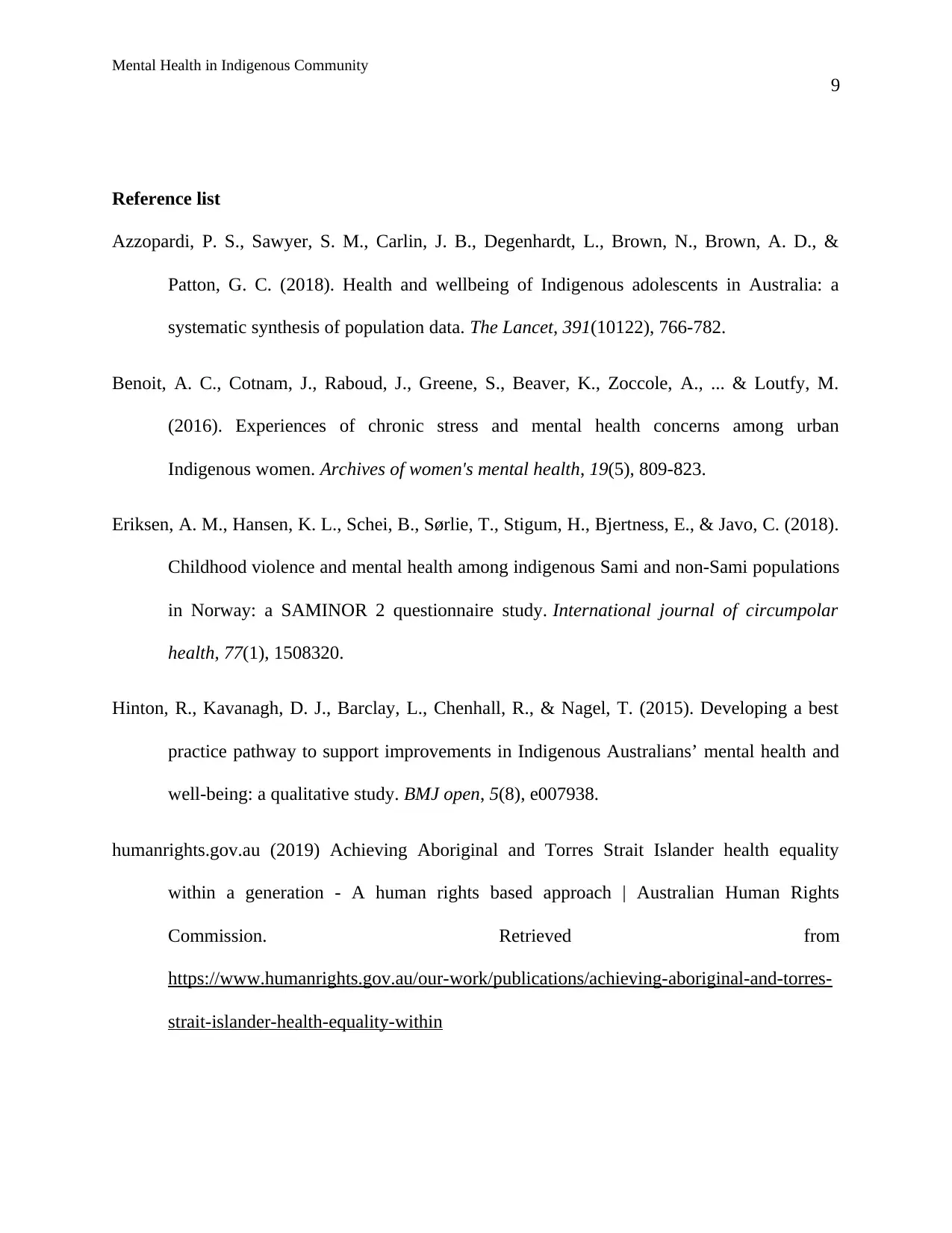
Mental Health in Indigenous Community
9
Reference list
Azzopardi, P. S., Sawyer, S. M., Carlin, J. B., Degenhardt, L., Brown, N., Brown, A. D., &
Patton, G. C. (2018). Health and wellbeing of Indigenous adolescents in Australia: a
systematic synthesis of population data. The Lancet, 391(10122), 766-782.
Benoit, A. C., Cotnam, J., Raboud, J., Greene, S., Beaver, K., Zoccole, A., ... & Loutfy, M.
(2016). Experiences of chronic stress and mental health concerns among urban
Indigenous women. Archives of women's mental health, 19(5), 809-823.
Eriksen, A. M., Hansen, K. L., Schei, B., Sørlie, T., Stigum, H., Bjertness, E., & Javo, C. (2018).
Childhood violence and mental health among indigenous Sami and non-Sami populations
in Norway: a SAMINOR 2 questionnaire study. International journal of circumpolar
health, 77(1), 1508320.
Hinton, R., Kavanagh, D. J., Barclay, L., Chenhall, R., & Nagel, T. (2015). Developing a best
practice pathway to support improvements in Indigenous Australians’ mental health and
well-being: a qualitative study. BMJ open, 5(8), e007938.
humanrights.gov.au (2019) Achieving Aboriginal and Torres Strait Islander health equality
within a generation - A human rights based approach | Australian Human Rights
Commission. Retrieved from
https://www.humanrights.gov.au/our-work/publications/achieving-aboriginal-and-torres-
strait-islander-health-equality-within
9
Reference list
Azzopardi, P. S., Sawyer, S. M., Carlin, J. B., Degenhardt, L., Brown, N., Brown, A. D., &
Patton, G. C. (2018). Health and wellbeing of Indigenous adolescents in Australia: a
systematic synthesis of population data. The Lancet, 391(10122), 766-782.
Benoit, A. C., Cotnam, J., Raboud, J., Greene, S., Beaver, K., Zoccole, A., ... & Loutfy, M.
(2016). Experiences of chronic stress and mental health concerns among urban
Indigenous women. Archives of women's mental health, 19(5), 809-823.
Eriksen, A. M., Hansen, K. L., Schei, B., Sørlie, T., Stigum, H., Bjertness, E., & Javo, C. (2018).
Childhood violence and mental health among indigenous Sami and non-Sami populations
in Norway: a SAMINOR 2 questionnaire study. International journal of circumpolar
health, 77(1), 1508320.
Hinton, R., Kavanagh, D. J., Barclay, L., Chenhall, R., & Nagel, T. (2015). Developing a best
practice pathway to support improvements in Indigenous Australians’ mental health and
well-being: a qualitative study. BMJ open, 5(8), e007938.
humanrights.gov.au (2019) Achieving Aboriginal and Torres Strait Islander health equality
within a generation - A human rights based approach | Australian Human Rights
Commission. Retrieved from
https://www.humanrights.gov.au/our-work/publications/achieving-aboriginal-and-torres-
strait-islander-health-equality-within
⊘ This is a preview!⊘
Do you want full access?
Subscribe today to unlock all pages.

Trusted by 1+ million students worldwide
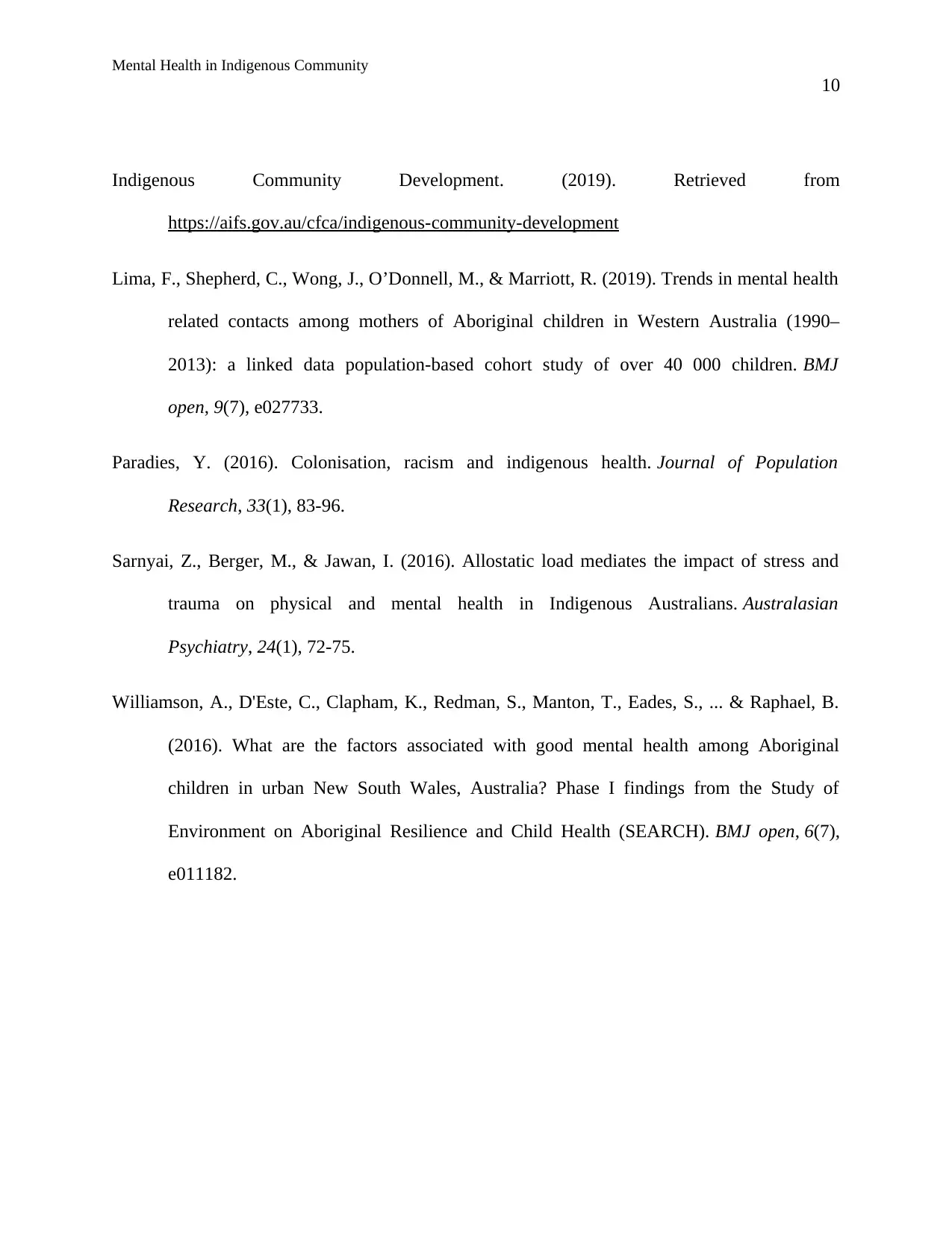
Mental Health in Indigenous Community
10
Indigenous Community Development. (2019). Retrieved from
https://aifs.gov.au/cfca/indigenous-community-development
Lima, F., Shepherd, C., Wong, J., O’Donnell, M., & Marriott, R. (2019). Trends in mental health
related contacts among mothers of Aboriginal children in Western Australia (1990–
2013): a linked data population-based cohort study of over 40 000 children. BMJ
open, 9(7), e027733.
Paradies, Y. (2016). Colonisation, racism and indigenous health. Journal of Population
Research, 33(1), 83-96.
Sarnyai, Z., Berger, M., & Jawan, I. (2016). Allostatic load mediates the impact of stress and
trauma on physical and mental health in Indigenous Australians. Australasian
Psychiatry, 24(1), 72-75.
Williamson, A., D'Este, C., Clapham, K., Redman, S., Manton, T., Eades, S., ... & Raphael, B.
(2016). What are the factors associated with good mental health among Aboriginal
children in urban New South Wales, Australia? Phase I findings from the Study of
Environment on Aboriginal Resilience and Child Health (SEARCH). BMJ open, 6(7),
e011182.
10
Indigenous Community Development. (2019). Retrieved from
https://aifs.gov.au/cfca/indigenous-community-development
Lima, F., Shepherd, C., Wong, J., O’Donnell, M., & Marriott, R. (2019). Trends in mental health
related contacts among mothers of Aboriginal children in Western Australia (1990–
2013): a linked data population-based cohort study of over 40 000 children. BMJ
open, 9(7), e027733.
Paradies, Y. (2016). Colonisation, racism and indigenous health. Journal of Population
Research, 33(1), 83-96.
Sarnyai, Z., Berger, M., & Jawan, I. (2016). Allostatic load mediates the impact of stress and
trauma on physical and mental health in Indigenous Australians. Australasian
Psychiatry, 24(1), 72-75.
Williamson, A., D'Este, C., Clapham, K., Redman, S., Manton, T., Eades, S., ... & Raphael, B.
(2016). What are the factors associated with good mental health among Aboriginal
children in urban New South Wales, Australia? Phase I findings from the Study of
Environment on Aboriginal Resilience and Child Health (SEARCH). BMJ open, 6(7),
e011182.
1 out of 10
Related Documents
Your All-in-One AI-Powered Toolkit for Academic Success.
+13062052269
info@desklib.com
Available 24*7 on WhatsApp / Email
![[object Object]](/_next/static/media/star-bottom.7253800d.svg)
Unlock your academic potential
Copyright © 2020–2025 A2Z Services. All Rights Reserved. Developed and managed by ZUCOL.





